Tarnished plant bug damage on vegetable crops
Learn about identification and general management guidelines for the tarnished plant bug (TPB) (Lygus lineolaris) which is a common pest of several fruit crops and a number of vegetable crops in Ontario.
Introduction
The tarnished plant bug (TPB) (Lygus lineolaris) is a common pest of several fruit crops in Ontario and a number of vegetable crops including celery, lettuce, broccoli, cauliflower, Chinese cabbage, edible amaranths, snap beans, pepper, eggplant, potato, tomato and spinach. Both the adult and the immature stages damage crops. They are easily identified by characteristic markings and behaviour patterns (see Figure 1).
Adult bugs have a characteristic shiny yellow to brown-black appearance with a distinctive triangular pattern on their backs. They are about 5 mm long. These adults fly from plant to plant in short bursts. It is the adult form that over-winters in Ontario, usually in protected areas such as crop debris, hedge rows, and weedy areas.
The green nymphs are small, wingless and move very quickly when disturbed. Although they look like aphids when they are small, the rapid movement of TPB nymphs and their lack of the characteristic aphid cornicles or "tailpipes" make them easy to identify. Their rapid movement makes monitoring for TPB difficult on all the crops they attack.
Some monitoring programs have been developed for crops such as celery, potato and strawberry (see OMAFRA fact sheet Tarnished Plant Bug: A Major Pest of Strawberry, Order No. 92-108). These programs depend upon counting the TPB on a number of individual plants. This can be a difficult procedure depending upon the crop and time of day. During hot, dry periods, the TPB will move often and quickly within fields and between farms. Many other plant species and some common weeds are also good hosts for TPB. Alfalfa and corn fields near vegetable crops are major sources of TPB and populations of redroot pigweed, chickweed, dandelion and all types of mint in and around commercial vegetable fields will increase the likelihood of TPB infestation. During first and second cuts of alfalfa, large populations of TPB migrate into adjacent susceptible crops. (See Figure 2, TPB on weeds.)
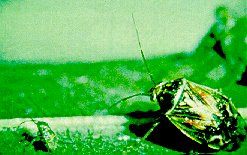
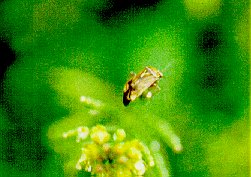
In many cases, damage from the TPB is seen before the insect itself, thus, recognition of the damage symptoms is very important. The saliva of TPB is toxic to plants and this leads to the necrotic lesions and secondary rots associated with their feeding.
This fact sheet will summarize symptoms of damage, monitoring guidelines and management options for several vegetable crops. For pesticide recommendations consult the latest edition of OMAFRA Publication #363, Vegetable Production Recommendations. For IPM information there are two publications available for muck crops and cole crops. IPM for Onions, Carrots, Celery and Lettuce in Ontario, Order No. 700 and IPM for Crucifer Crops in Ontario, Order No. 701, provide good diagnostic, monitoring and management information for celery, lettuce, broccoli and cauliflower. The book Diseases and Pests of Vegetable Crops in Canada, 1994, ISBN 0-9691627-3-1, also provides information about TPB damage and management for a number of vegetable crops.
TPB is a warm weather pest, normally laying eggs at temperatures above 20°C. There is a degree day model which helps to predict the appearance of first nymphs which tend to damage many vegetables. Degree day accumulations for TPB need to begin on April 1st from a base temperature of 12.4°C. The number of degree days above this base temperature required for first emergence of nymphs is about 35-40. Since TPB lives at ground level, degree day forecasts are more accurate if the weather equipment is placed at that level. For most vegetable crops it is essential to visually monitor for TPB adults and nymphs throughout the growing season.
Celery
Early damage symptoms may appear as a yellowing or wilting of leaflets, tipburn-like symptoms on the new growth or small punctures along the stalks. TPB damage on celery is often complicated by secondary bacterial infections which lead to larger necrotic lesions along the stalks and/or soft rot symptoms in the heart of the plant (see Figures 3, 4 and 5).
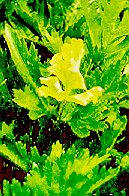
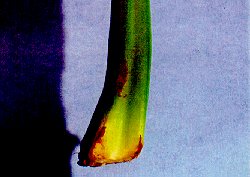
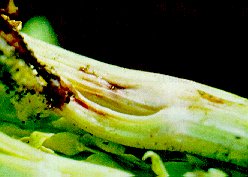
Sweep nets and coloured sticky traps can be used to track TPB adult movements in and around fields, however, neither method gives much information about potential damage to the crop. Direct inspection of celery plants is the most effective method. Randomly check 50-100 plants, looking directly into the heart leaves (see Figure 6). TPB adults will fly out of the plant, whereas the green nymphs will jump off onto the ground and run. These insects are fast moving especially during the warm midday. Record the number of TPB adults and nymphs found and divide by the number of plants sampled to give a TPB per plant value. For celery crops the thresholds are as follows: from transplanting until three weeks before harvest the tolerance is 0.2 TPB/plant. During the last three weeks before harvest the tolerance drops to 0.1 TPB/plant. These thresholds are only guidelines and it should be noted that in many cases, damage from TPB is observed before large numbers of TPB nymphs and/or adults are seen.
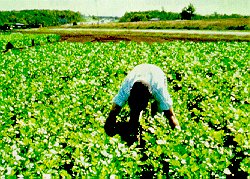
Lettuce/Spinach/Chinese cabbage
TPB damage to lettuce, spinach and Chinese cabbage can reduce the marketability of these crops considerably and make them more susceptible to bacterial diseases. TPB stings can occur anywhere on the plant, however, they tend to be found mostly on the inside and outside of the midribs of leaves (see Figures 7 and 8). TPB also feed on the youngest growth in the heart of the plant which may lead to symptoms similar to blackheart.
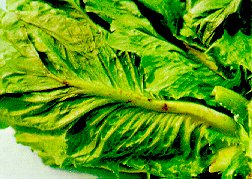
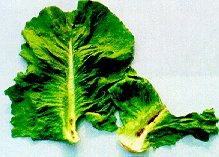
Monitoring for TPB levels and damage in lettuce, spinach and Chinese cabbage is the same as for celery. Thresholds have not been specifically established for these crops, however, the thresholds used in celery have proven to be a suitable guideline for management decisions. Weed control, early cutting of neighbouring alfalfa fields, and early detection of TPB in the crop are key considerations.
Broccoli/Cauliflower/Asian greens
Damage to the marketable portions of broccoli and cauliflower has increased in prevalence in recent years, however, TPB is considered an occasional pest of these two crops. On cauliflower, TPB feeding causes a brown streaking along the surface of the curd. On broccoli, feeding damage is indicated by dry, shrivelled, brown beading scattered across the head (see Figure 9). As with other crops, such damage predisposes the plants to secondary bacterial infections and decay. Damage to crops like pak choy, gai lan (Chinese broccoli), bok choy, choy sum, hinn choy (amaranth) and tung choy (water spinach) (See OMAFRA fact sheet, Asian Vegetables Grown in Ontario, Order No. 98-033) is normally indicated by lesions on stems, leaf petioles and flower stalks. Such damage often renders the crop unmarketable.
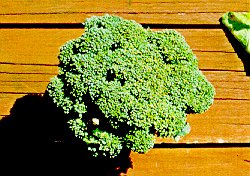
Monitoring for TPB in broccoli, cauliflower and Asian greens again requires individual plant inspections. Broccoli and cauliflower are susceptible after head formation, whereas many of the Asian greens are susceptible from seedling stage to maturity. There are no established thresholds, however, presence or absence is a good guideline to follow.
Pepper/Eggplant
Early feeding damage is often confined to flower buds resulting in their abortion (see Figure 10). Losses can be up to 100% in severe cases. Symptoms on pepper and eggplant fruit are less common. Cloud spotting similar to that seen on tomato can occur on both pepper and eggplant.
Monitoring for TPB on pepper and eggplant requires individual plant inspections from flower bud formation onwards. Twice weekly inspections are recommended as a minimum. There are no established thresholds, however, presence or absence is a good guideline to follow. (See Figure 11)
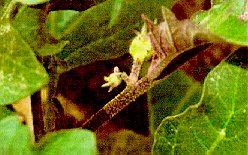
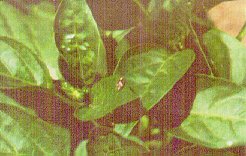
Tomato
TPB damage is generally confined to the fruit of tomato. TPB adults and nymphs feed on the fruit and pierce the skin with their mouth parts. Damage to green fruit causes fruit to be malformed and dimpled. On ripe fruit, the effects of their feeding toxin leads to white, circular spots on the fruit. This is referred to as "cloud-spotting" and makes the fruit difficult to peel (see Figures 12 and 13). ("Ghost-spotting" is the result of an aborted Botrytis infection.) For whole pack and fresh market tomatoes this damage can make the crop unmarketable. Damage to tomatoes from stink bugs is also similar to that caused by TPB.
It is important to monitor tomato crops when fruit formation begins. This is especially important during the first cut of nearby alfalfa fields. Damage to ripe fruit can occur well into September and fields should continue to be monitored. Fields of other susceptible crops near tomato fields should also be checked regularly for TPB populations. Individual plant inspections are necessary especially where there has been a history of TPB pressure. There are no established thresholds, however, presence or absence is a good guideline to follow.
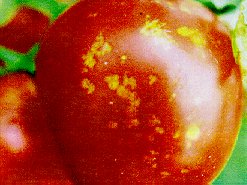
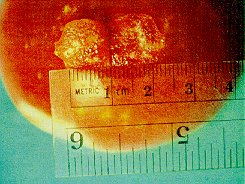
Potato
TPB damage to potato is generally confined to flowers and leaflets. Usually the first indication of TPB damage on potato is the wilting of the top leaflets followed by a noticeable abortion of flowers and small forming fruit (see Figure 14). This does not cause any marketable loss to potato yield. On leaflets TPB feed both on petioles and midribs. Resulting damage may appear as small, irregular feeding holes in the foliage or as necrotic lesions on the petioles and leaf midrib (see Figures 15 and 16). The TPB feeding toxin may also cause distortion and twisting of leaflets. If feeding on leaflets is severe, they may turn yellow, brown or dry up. To date, this type of damage to potato and its effect on yield has not been determined. TPB is also reported to spread the potato spindle tuber viroid which causes oblong-shaped potatoes.
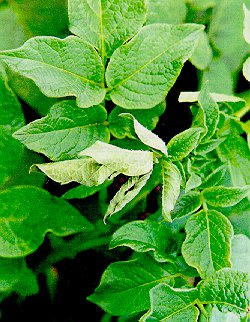
Monitoring for TPB on potato involves the use of a sweep net to catch TPB adults. Sweep nets work best when the foliage is dry. Twenty-five sweeps in a potato field is sufficient for measuring the threat from TPB. A sweep equals one pass over the crop foliage. The established threshold for TPB in potatoes is 25 adult TPB per 25 sweeps.
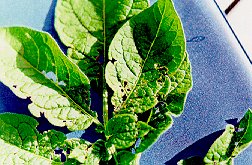
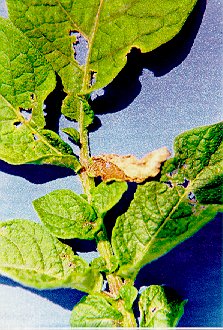
Cucurbits
TPB may feed on flowers, leaves and stems of cucurbit crops like cucumber, squash, melons, pumpkin and zucchini. TPB feeding can reduce flower set and stunt new shoot growth if damage is severe, however, in most cases, no control measures are required.
Snap beans
Damage to snap beans from TPB nymphs and adults is confined generally to flowers and fruit. Flower abortion may occur when TPB sting the flowers. Damage to bean pods consists of pin-point injury surrounded by a white halo. This damage, if severe, can make the beans unmarketable or of a lower grade. The TPB feeding toxin may also distort the shape of the bean pod.
Monitoring for TPB requires individual plant inspections especially during warm, dry periods and where there is a history of TPB pressure.
General management guidelines
Over-wintering areas
Fence rows, leaf litter, areas of plant debris, hedgerows, brush piles, wood lots, alfalfa fields and weedy areas are good sites for the adult TPB to over-winter. Wherever possible it is helpful to clean up such areas and remove weed hosts of TPB.
Cultivar selection
For the vegetable crops affected by TPB, there is no information about the susceptibility or tolerance of varieties to TPB injury.
Alfalfa fields
Vegetable crops located near alfalfa fields need to be carefully monitored just prior to, during, and after cutting since TPB can move into alternative host crops. When alfalfa is cut before the majority of the TPB population reaches the adult stage, migration from alfalfa to susceptible host crops may be reduced. This can only be determined if adjacent alfalfa fields are also checked regularly.
Weed management
Removal of broadleaf weed hosts in and around vegetable fields may help to reduce the buildup of resident TPB populations. Season-long weed management may help to reduce the over-wintering TPB population also. Make note of periods of drought stress, as weed hosts may become unsuitable for TPB resulting in their migration to susceptible vegetable crops.
Site selection
It is best to avoid planting susceptible vegetable crops in areas of potentially high TPB activity. A non-susceptible buffer crop in such areas may help protect more sensitive vegetables from TPB damage.
Biocontrol
At present there is no economically effective biocontrol method, although several native species of egg and nymphal parasites are known to be present. Research is underway in Ontario to increase beneficial diversity by introducing a new species of parasitic wasp that will help decrease TPB populations in forage and weed hosts. This may reduce the numbers of TPB migrating into nearby fruit and vegetable crops. In future, biocontrol methods should play a more important role in TPB management.
Chemical control
For vegetable crops, dimethoate, endosulfan and several of the synthetic pyrethroids are labeled for TPB control, however, this varies with the crop. Consult OMAFRA Publication 363, Vegetable Production Recommendations under each crop for details. Repeated use of any insecticide should be avoided so that the development of resistance problems is reduced. Insecticides should only be used when necessary and at threshold levels if established.
The authors extend their thanks to the following individuals for assistance with the manuscript and technical content of this fact sheet: Dr. Ron Pitblado, University of Guelph, RCAT; Donna Speranzini, OMAFRA, Vineland; Dr. Eugenia Banks, Potato Specialist, OMAFRA, Guelph and Dr. Bruce Broadbent, AAFC, London.